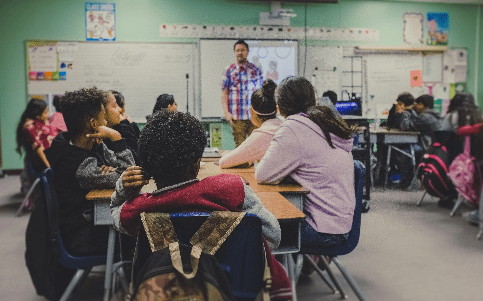ACER LANTITE Practice Test Page

The ACER LANTITE Test is an exam for prospective teachers, and is also known as the Literacy and Numeracy Test for Intitial Teacher Education.
You will see 65 questions on the ACER LANTITE, and you will have 2 hours to complete the test.
For the exam, you will need to read documents related to teaching and teacher administration. There will also be a few questions on grammar and sentence correction.
ACER LANTITE Practice Literacy Test
Instructions: Read the passage and answer the questions that follow. To finish the exam within the time limit, it may be beneficial to read the questions below first, then skim the text to find the answers. Then check your answers in the next section.

1. What’s the difference between teaching engineering and economics? Is explicating concepts and facts to others the same procedure, regardless of the discipline? Absolutely not, says Amelia Emerson, who teaches older adults painting and decorating skills. “When I did my certificate of education at college, I felt it was more for academic teachers than vocational teachers like me,” she says. “For me, I felt it wasn’t useful.”
2. This and similar complaints are why a new project is underway to assist colleges that train students to teach vocational subjects. The Edge Foundation is a charity receiving governmental support in order to aid in practical and vocational learning and has agreed to fund the development and approval of new courses. The first 30 teacher trainees are to commence work on their certificates and diplomas later this month. Unlike previous teachers in training, these students, who want to teach vocational subjects like construction and photography, will not have to waste time by composing essays on pedagogy, says Joseph Smith, the college’s president. When the students get together, they will be sharing their teaching techniques with each another. For the majority of the time they will actually be teaching, says Smith. “Teacher training should be work-based learning. Students in vocations are not going to learn by sitting in classrooms.”
3. Gavin Martin, 37, is one of the new teachers participating in the Edge Foundation’s program. After more than a decade working as a carpenter, he is now learning how to teach. “I have taught a few apprentices on site, and I really enjoyed doing it. Nobody’s born knowing how to use tools. We all have to learn in a hands-on way,” he says.
4. “Historically, the view of official governing bodies has always been that teachers should have academic degrees,” says Martin. However, in the past ten years or so, vocational teaching has come under the spotlight. He explains that “employers of teachers were telling us that while we were enhancing their academic skills, what was really needed was teachers who were better at teaching.” Emphasizing that the new courses will focus entirely on subject-specific teaching skills, Martin said: “Trainees were getting a very solid foundation in teaching skills in general, but they were not getting sufficient teaching in their subject areas.” To rectify that shortcoming, each trainee on the new course will work with a mentor who teaches in their subject area. They will submit videos of themselves teaching, rather than formal essays, and they will receive special cameras to record their own lessons.
5. In addition to these reforms in teacher training, new programs are also underway to improve the educational system itself. The government has earmarked funds for the Excellence in Education project, which was introduced at various colleges around the country yesterday. The project celebrates achievement in colleges and champions the work taking place under the leadership of gifted professionals.
6. Yet, across the world, it is a challenge to raise educational standards for everyone. In Melbourse, for instance, results for ethnic minority children are rising faster than the average. Thus, what is needed is a far more plural system. So, if a college can attract students and meet basic standards, it should be able to receive governmental funding and students should have the right to find their places.
7. In addition, we need a rigorous concentration on academic standards. The government was right to address this problem in educational reforms last year, but we need to go further. We should also reform the exam system to ensure that there is no devaluation of academic standards and college graduates have the skills required for a more competitive job market.
8. Besides reforming teacher training programs and improving academic standards, the physical premises where education takes place, namely college and school buildings, need to be considered. An influential pressure group has questioned the value of the government’s $45 billion program to replace or refurbish all high schools and colleges over the next 15 years. Governmental officials on the Education Select Committee will suggest that some of the cash might be better directed to making buildings more environmentally sustainable, reducing carbon emissions, or boosting pre-school learning. An increase in university research budgets should also be considered, they suggest.
Questions

1. What is the main purpose of paragraphs 1 to 4 of this article?
- (A) To describe new educational reforms in general
- (B) To summarize the views of teachers to a new education policy
- (C) To provide details about a new teacher training program
- (D) To point out current controversies in educational reform
2. According to the article, what will new teacher trainees not be required to do?
- (A) Work-based teaching and learning
- (B) Develop new courses and get them approved
- (C) Earn a certificate or diploma
- (D) Write essays about teaching methods
3. Why does the author mention minority children from Melbourne in paragraph 6?
- (A) To demonstrate the difficulty of raising educational standards
- (B) To argue for a more diverse educational system
- (C) To show that schools need funding more than students
- (D) To illustrate the needs of minority children
4. According to the article, what two reforms of the examination system are currently necessary? (Choose 2)
- (A) Ensuring that new teachers have the necessary skills
- (B) Maintaining fairness to minority students
- (C) Increasing the plurality and diversity of the system
- (D) Making sure exams are not devalued
- (E) Protecting and maintaining academic standards
- (F) Providing more funding for exams
5. What question surrounds the $45 billion program to reform existing school buildings?
- (A) Whether the buildings should be replaced or refurbished
- (B) Whether the buildings should be environmentally friendly
- (C) What the money should actually be spent on
- (D) What the best upgrade of research facilities would be
Answers to the ACT LANTITE Practice Test

The answers to the ACER LANTITE ( Literary and Numeracy Test for Initial Teacher Education) practice reading test can be found below.
1) The correct answer is C. Paragraphs 1 to 4 talk about “a new project [that] is underway to assist colleges that train students to teach vocational subjects” (paragraph 2).
2) The correct answer is D. Paragraph 2 states: “The first 30 teacher trainees are to commence work on their certificates and diplomas later this month. Unlike previous teachers in training, these students, who want to teach vocational subjects like construction and photography, will not have to waste time by composing essays.”
3) The correct answer is B. Paragraph 6 states that “results for ethnic minority children are rising faster than the average. Thus, what is needed is a far more plural system.” “Plural” is synonymous with “diverse.”
4) The correct answers are A and E. Paragraph 7 tells us that the system needs to “ensure that there is no devaluation of standards and college graduates have the skills required for a more competitive job market.”
5) The correct answer is C. Paragraph 8 explains: “Governmental officials on the Education Select Committee will suggest that some of the cash might be better directed to making buildings more environmentally sustainable . . . or boosting pre-school learning.”
More practice materials
Official LANTITE Practice Math Test
Note: LANTITE and the Literacy and Numeracy Test for Initial Teacher Education are trademarks of the Australian Council for Educational Research (ACER), which is not affiliated with this website.